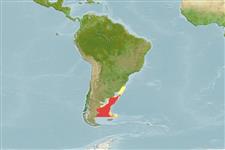Common names from other countries
Cephalopoda |
Oegopsida |
Ommastrephidae | Illicinae
Environment: milieu / climate zone / depth range / distribution range
Ecology
Pelagic; depth range 0 - 800 m (Ref. 275), usually 50 - 200 m (Ref. 275). Subtropical, preferred 10°C (Ref. 107945); 20°S - 50°S, 68°W - 46°W (Ref. 275)
Southwest Atlantic, Southeast Pacific and Antarctic Indian Ocean. Subtropical to polar.
Length at first maturity / Size / Weight / Age
Maturity: Lm ?, range 24 - ? cm Max length : 40.0 cm ML male/unsexed; (Ref. 105659)
Life cycle and mating behavior
Maturity | Reproduction | Spawning | Eggs | Fecundity | Larvae
Members of the class Cephalopoda are gonochoric. Male and female adults usually die shortly after spawning and brooding, respectively. Mating behavior: Males perform various displays to attract potential females for copulation. During copulation, male grasp the female and inserts the hectocotylus into the female's mantle cavity where fertilization usually occurs. Life cycle: Embryos hatch into planktonic stage and live for some time before they grow larger and take up a benthic existence as adults.
Roper, C.F.E., M.J. Sweeney and C.E. Nauen. 1984. (Ref. 275)
IUCN Red List Status
(Ref. 130435: Version 2025-1)
CITES status (Ref. 108899)
Not Evaluated
Not Evaluated
Threat to humans
Human uses
Fisheries: commercial
FAO - Fisheries: landings, species profile | FishSource | Sea Around Us
Tools
More information
PhysiologyOxygen consumption
Human RelatedStamps, coins, misc.
Internet sources
Estimates based on models
Preferred temperature
(Ref.
115969): 4.4 - 12.1, mean 7.3 (based on 234 cells).
Resilience
High, minimum population doubling time less than 15 months (K=0.93-0.96).
Prior r = 1.00, 95% CL = 0.66 - 1.49, Based on 1 data-limited stock assessment.
Fishing Vulnerability
Low vulnerability (21 of 100).
Climate Vulnerability
Low vulnerability (25 of 100).
Nutrients : Calcium = 126 [75, 177] mg/100g; Iron = 4.79 [1.67, 7.92] mg/100g; Protein = 15.5 [13.7, 17.4] %; Omega3 = 0.414 [0.262, 0.566] g/100g; Selenium = 57.8 [48.5, 67.2] μg/100g; VitaminA = 0 μg/100g; Zinc = 1.97 [0.92, 3.02] mg/100g (wet weight); based on
nutrient studies.
